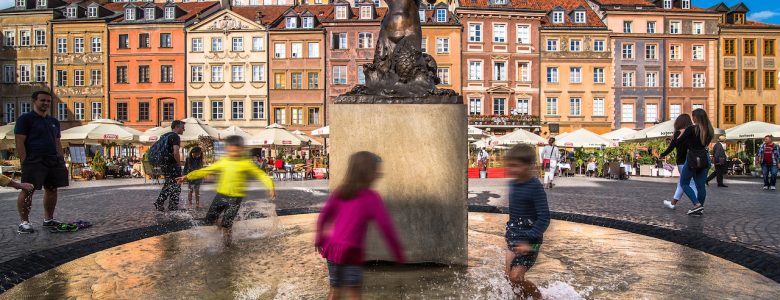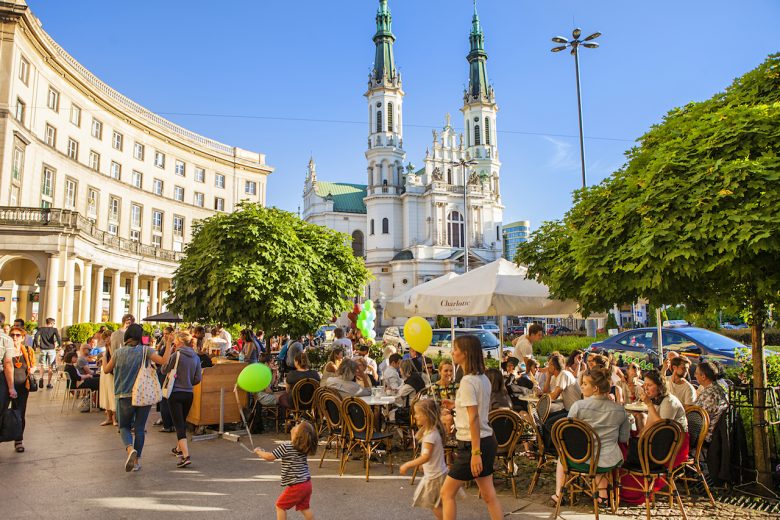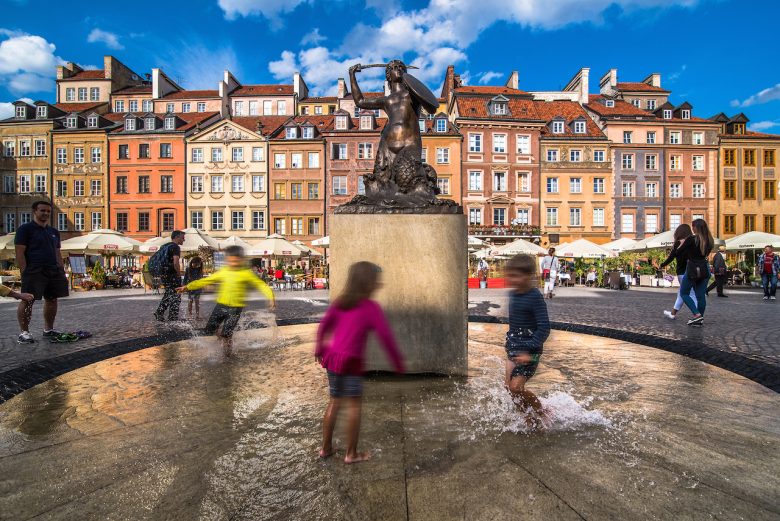
Around 8.3 million tourists travel to Poland’s capital city each year to walk through the pages of history textbooks, explore castles and royal gardens, and rediscover their love of Chopin’s classical music. All this culture and history comes at an affordable price tag too, which makes it the perfect European destination for a family holiday, especially as a large number of locals speak English.

Courtesy of the City of Warsaw© Warsaw Tourist Office
The Palace of Culture and Science
To get your bearing in Poland’s burgeoning capital city, start off with spectacular panoramic views of the cityscape from the viewing terrace on the 30th floor of the country’s tallest building.
Though it may be Poland’s most recognizable building (at 237 metres) the Palace of Culture and Science has a controversial past. It was constructed in 1955 by Soviet architect Lev Rudnev in a Stalinist architectural style, similar to Moscow’s ‘Seven Sisters’ skyscrapers, and gifted to Poles by Stalin, who ruled the then communist satellite state with an iron fist. These days the skyline is punctuated with skyscrapers, proof that Warsaw is one of Europe’s fastest-growing economies.
Take a guided tour from the basement to the viewing terrace; otherwise explore the skyscraper’s four theatres, cinema, two museums (the Museum of Technology and the Dollhouse Museum), two orchestras, two libraries, shopping mall and the buffet of restaurants and cafés.
Tip:
The Warsaw Tourist Office is on the ground floor facing Emilii Plater Street. Here you’ll find resources to help plan your trip. Also download the tourism board’s free Warsaw Tour app for Android and iTunes.
Old Town

Courtesy of the City of Warsaw© Warsaw Tourist Office
Warsaw’s colourful Old Town (Stare Miasto) is actually the world’s youngest old town. It was almost entirely reconstructed – by architects, art historians and residents – using its own rubble after 90% of the town was destroyed during the Second World War. Today it’s a UNESCO World Heritage Site that’s alive with activity. Castle Square is an open-air stage for musical and theatrical performances, an art gallery for local artists, and the meeting point for many free walking tours. It is bordered by the 15th century toffee-coloured Royal Castle on the one side, as well as historical townhouses converted into cosy cafés, restaurants and boutique hotels on the other.
For bird’s-eye views of the square, the Vistula River and the National Stadium ascend St Anne’s Church tower. From here you’ll also see the 11km-long, cobbled Royal Route that’s flanked by wealthy villas and leads towards two other royal residences: the 76-hectare Łazienki Royal Park with its luscious gardens, and the opulent Wilanów Palace, which remained untouched during both World Wars. Entrance is free to both on Thursdays.
A walk through World War II
Join one of the many free walking tours, which begin at Sigismund’s Tower in Castle Square to get a sense of the Second World War beyond the history textbooks. The witty guides will take you along a timeline of events that occurred during the six years during which Poland was occupied.
The two-hour tour explains the German-Soviet invasion of 1939 by pointing out important landmarks, statues and monuments, and also uses primary sources such as black-and-white photographs to give you then-and-now comparisons. It also takes you in the footsteps of the civil and military resistance during the Jewish Ghetto Uprising of 1943 and the Warsaw Uprising of 1944. After you bear witness to the bravery and tragedy of everyday life during the war, you’ll understand why Warsaw is called the phoenix city that rose from the ashes.
Picnicking along the Vistula River and the legend of the Warsaw mermaid
If you sit along the banks of the Vistula River (Poland’s largest and longer river) and listen carefully, you may hear the melodic singing of Warsaw’s mermaid. Legend has it that a mermaid came to rest on the riverbank near the Old Town and loved it so that she decided to call it home. The local fishermen, upset that something was tangling their fishing nets and freeing the fish, set out in search of the offender. When they heard her singing and saw her beauty they instantly fell in love. All but a greedy merchant, who imprisoned her in a hut and wanted to take her on a road show around the country. After the mermaid was rescued by the fishermen, she promised to protect Warsaw’s residents. You’ll see statues of her, armed with a sword and shield, around the city (Old Town Square, Świętokrzyski Bridge and on Karowa Street).
The riverfront promenades along the Vistula are Europe’s largest urban river beaches and offer beautiful views of the bridges that arch over the river and the Old Town (if you’re on the right bank). It’s the perfect place for a picnic, to sun tan or read a book. In the warmer months there are deck chairs and hammocks laid out on the sand, as well as ball games in play. Prepare a picnic basket, eat at the many riverside cafés and bars or grill sausages at the bonfire pits.
The multimedia fountain park

Courtesy of the City of Warsaw© Warsaw Tourist Office
Between early May and late September on the left bank of the Vistula, near the Old Town, you’ll be enthralled by the musical fountains that are synchronised with 295 LED lights and lasers at the free multimedia fountain park. The wall of water created by 367 nozzles that shoot 800 cubic metres of water 25 metres into the air becomes a water canvas to showcase specially created films and visual shows about Warsaw, that are accompanied with Chopin’s concertos and hit music by the likes of Lady Gaga.
Though various shows run from Sunday to Thursday (4pm to 10:30pm), the best time to visit is on Friday and Saturday from 9pm for the main performance. Make sure you come early to get the best view, as crowds gather near the fountain with their cameras and smartphones well ahead of time.
Neon Museum
For something rather unusual visit the dazzling Neon Museum, which preserves Cold War-era neon signs within a restored warehouse in the Soho Factory arts complex in the gentrified Praga district. There are over 200 neon letters and other electro-graphic artefacts in the small private museum, which started as a documentary project in 2005. It is testament to the so called ‘great neonisation’ campaigns that swept across the former Eastern Bloc during communism. It’s the only museum of its kind on the continent. The museum also restores some of the city’s most iconic signs, like the famous mermaid on Grójecka Street among others.
The Copernicus Science Centre (Centrum Nauki Kopernika)

Courtesy of the City of Warsaw© Warsaw Tourist Office
You won’t find any glass cabinets at the Copernicus Science Centre, as this 22 000m2 exhibition space has six interactive, permanent exhibitions and over 400 exhibits, grouped according to subject, such as: the high voltage and robotic theatre, humans and the environment, roots of civilisation, and lightzone to name a few.
It inspires children (and adults) to observe the laws of the universe and to try solve engineering and scientific challenges, when they conduct experiments using everyday objects – straws, paper, paperclips, balls, elastic bands – at the science labs. Why not interact with a robot, jump on a magic flying (hovering) carpet, observe hot air balloons rise and sink, and board a ‘sinking’ ship.
The ‘explainers’, who speak English, Russian, French, German, Spanish and know sign language, can explain any concepts, though you’re encouraged to figure it out through trial and error and by reading the multilingual explanation cards. And with an on-site planetarium, don’t expect to spend less than three to five hours exploring at your own leisure.

Courtesy of the City of Warsaw© Warsaw Tourist Office

Courtesy of the City of Warsaw© Warsaw Tourist Office
Chopin’s Warsaw
Fryderyk Chopin is undoubtedly Warsaw’s most famous son. The concert pianist and composer spent the first 20 years living in the city studying music and performing his first concerts from the age of eight. It’s no surprise that the city has the world’s largest Chopin memorabilia collection and pays tribute to him wherever you go.
Explore Chopin’s Warsaw by downloading the free Selfie with Chopin and Chopin’ Warsaw smartphone apps that will take you through the streets of Poland’s capital city in search of the Fryderyk Chopin Museum (with its impressive mural), as well as the Holy Cross Church, where his heart is embedded in a pillar of the Baroque church.
There are also a number of multimedia benches strategically placed around the city that follow his footsteps. Rest on them during your explorations and listen to his intricate compositions, while you read more about him on the apps. In the summer months, each Sunday, delight in the free Chopin concerts performed near his statue at Łazienki Royal Park.

Courtesy of the City of Warsaw© Warsaw Tourist Office
Free Thursdays
Each Thursday a number of museums open their doors for free to the public. Even if you spend the entire day exploring these museums, you probably won’t get through half of them. I recommend: POLIN Museum of the History of Polish Jews for a dose of World War II history relating to the Jews; as well as Zachęta National Gallery of Art or The Centre for Contemporary Art in Ujazdowski Castle for art lovers.
You can find the list of all the museums that are freely accessible on various days of the week here.